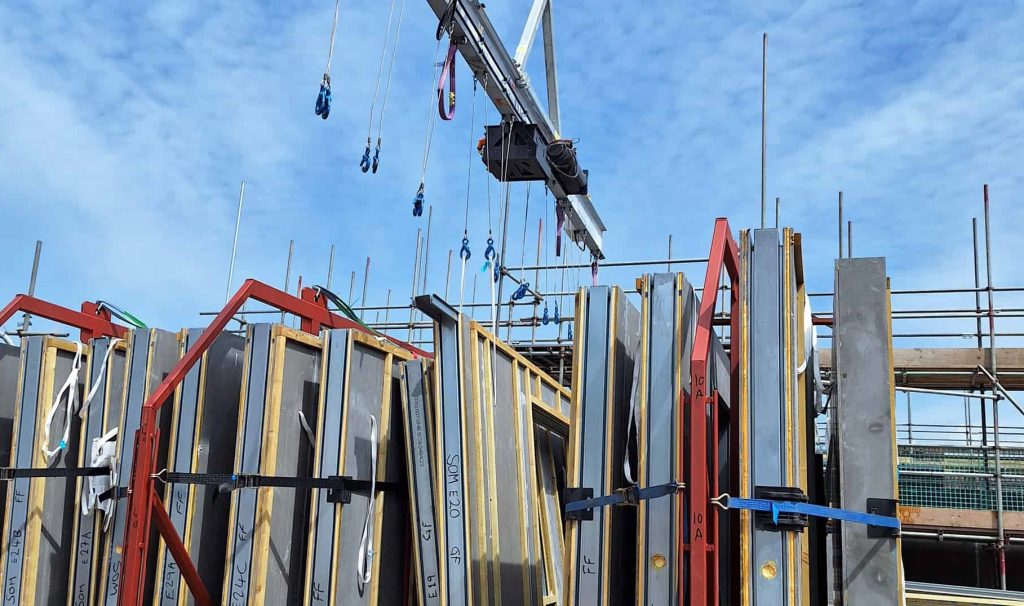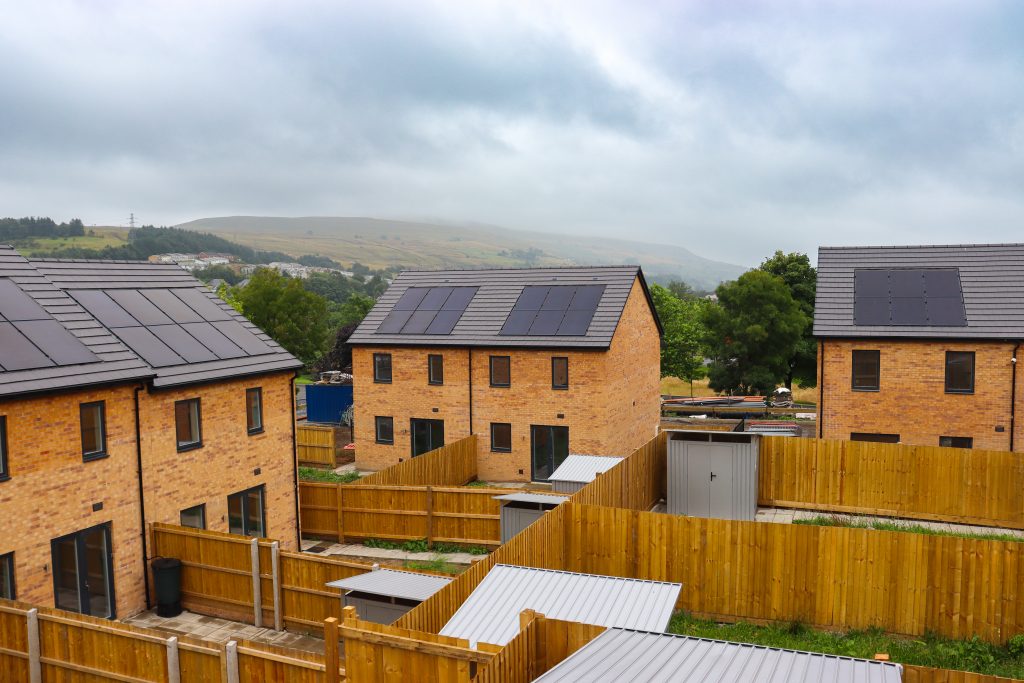With a year to go of this Senedd term, WHQ asked a range of different contributors for their views on Welsh Government’s target of 20,000 new low carbon social homes. Can it be met? What more can be done? And what should come next?
Doing something different
 While there are question marks over whether the target to deliver 20k social homes will be met by next year, and whether this target will meet the need, behind the figures and ambitions, families are living in inappropriate, poor quality and unaffordable housing, unacceptable numbers of children are living in temporary accommodation and people cannot live in the communities where they were born.
While there are question marks over whether the target to deliver 20k social homes will be met by next year, and whether this target will meet the need, behind the figures and ambitions, families are living in inappropriate, poor quality and unaffordable housing, unacceptable numbers of children are living in temporary accommodation and people cannot live in the communities where they were born.
These unprecedentedly challenging times require us to do something radically different.
Community-led housing (CLH) groups are playing a key role in helping councils, housing associations and developers to tackle the housing crisis, by creating genuinely affordable homes designed, developed, and managed for, and by, the local community.
But if we want to deliver and speed and scale, key changes are needed.
The current biggest barrier is access to suitable funding. Creating a revolving loan fund would allow the pipeline of existing groups to progress their schemes and help develop a thriving movement.
Local authorities need to support CLH projects and implement supportive planning policies to enable projects to come forward.
Housing associations should work in partnership with CLH groups to unlock development sites, garner support through the planning process, and truly put residents at the heart of decision making.
Community-led housing can help to create a more balanced housing system, one of collaboration, involvement, prevention, and integration. A different way of working can help to rebuild our broken system and allow communities to make decisions about their future homes and neighbourhoods.
How are you responding to the challenge? Can you do something different and support the CLH movement?
Casey Edwards is community-led housing project manager at Cwmpas
Living in limbo
 We need to be clearer about what the target is trying to achieve and acknowledge that adding new homes is only part of the story.
We need to be clearer about what the target is trying to achieve and acknowledge that adding new homes is only part of the story.
At the Bevan Foundation, we believe that the key to getting people moved on from temporary accommodation is to boost the supply of social homes. Social housing is the only tenure that can provide a truly affordable and secure housing option for those rebuilding their lives after homelessness. We’re talking about social homes in the truest sense, ie dwellings managed by a social landlord which are let at a social rent, regulated by the Welsh Government.
The 20,000 target is for homes for rent within the social sector and includes any dwelling where rent is paid to a social landlord. So, social homes are in there, but also intermediate rent and shared ownership. Only 84 per cent of homes delivered to date have been social homes. With the blockages in temporary accommodation, this should be 100 per cent.
The Bevan Foundation has also reported that the sale of social homes is having a significant effect on supply, despite the Right to Buy being abolished. A total of 387 social homes were sold on the open market during the three years 2021-24 – that’s one removed for every 20 homes added.
This is fuelled by the cost of bringing individual homes up to latest quality and energy efficiency standards. Whilst it is possible to see why it is happening, it is hard to justify to the record number of households living in the limbo of temporary accommodation.
Wendy Dearden is senior policy and research officer at the Bevan Foundation

A suspiciously round number
 Wales’s housing crisis is spiralling, and yet the government’s 20,000 social homes target is woefully inadequate. Last year alone, 67,000 households were on social housing waiting lists, with 13,500 presenting as homeless. But these figures barely scratch the surface—hidden homelessness is estimated to be nine times higher than official statistics suggest, and the problem is worsening year by year.
Wales’s housing crisis is spiralling, and yet the government’s 20,000 social homes target is woefully inadequate. Last year alone, 67,000 households were on social housing waiting lists, with 13,500 presenting as homeless. But these figures barely scratch the surface—hidden homelessness is estimated to be nine times higher than official statistics suggest, and the problem is worsening year by year.
Even for those who have a roof over their heads, the situation is bleak. Wales has the smallest, coldest homes in Europe—expensive to heat, unhealthy to live in, and environmentally disastrous. Simply put, we need far more than 20,000 homes.
At the same time, the UK housing market has been transformed into a profit-driven industry, with Buy-to-Let businesses making property the backbone of the economy. Homes—once places of security and stability—are now investment assets, leaving renters in precarious and desperate situations. The solution? More social housing, designed to provide long-term security.
But the biggest indicator that the 20,000 target is meaningless is its suspiciously round number. Not 19,994. Not 20,006. Just a neat 20,000. That’s not a number based on actual need; it’s a politically convenient figure—big enough to sound ambitious but small enough to seem achievable.
What we truly need is a bottom-up approach. Real people in real communities need real homes. Mrs Jones in a freezing flat doesn’t need a politician’s arbitrary number—she needs the right house in the right place. The real number required is likely terrifying, but until we face the truth, we’ll never solve the crisis. The focus must shift from political targets to genuine needs. Anything less is just another exercise in box-ticking while people continue to suffer.
Craig Ab Iago is cabinet member for environment at Cyngor Gwynedd
This must not be the end of the story
 A home is the foundation from which we build our lives. And yet, thousands of people across Wales are experiencing the trauma of homelessness.
A home is the foundation from which we build our lives. And yet, thousands of people across Wales are experiencing the trauma of homelessness.
All too often, a lack of affordable housing traps people in a cycle of homelessness. People are left in limbo on long social housing lists, watching out for rarely available private rented properties that fall within housing benefit rates.
Building more genuinely affordable homes – particularly those for social rent – has a key part to play in shifting the dial on homelessness in Wales. It’s imperative that all levers be pulled to overcome challenges and get us as close as possible to the 20,000 affordable homes target.
However, with the numbers of people stuck in temporary accommodation reaching record levels last year, this target cannot be regarded as the end of the story.
It is vital that we do more to ensure we are building the right homes in the right places. Taking on board learnings from the Ending Homelessness National Advisory Board’s ongoing work looking at how information on the housing needs of people experiencing homelessness informs supply planning is key, so we can match the new homes delivered with the ambition of ending homelessness.
And as new Members of the Senedd take up their seats in May 2026, we must secure clear and continued commitments to invest and build affordable housing at pace – especially housing for social rent. In recognising that secure homes are a fundamental part of living a healthy and happy life, our infrastructure of affordable and social homes should be a high-level priority in the new parliamentary term.
Debbie Thomas is head of policy and communications in Wales at Crisis
Let’s use empty homes
 The most exciting way to try and address the current housing crisis is to spend all our efforts devising better ways of building new homes and removing obstacles to doing so.
The most exciting way to try and address the current housing crisis is to spend all our efforts devising better ways of building new homes and removing obstacles to doing so.
But by far the quickest way to solve the current housing crisis is to bring existing empty homes back into use as social housing. The Senedd inquiry report Empty Properties in 2019 identified that there were 27,000 homes in Wales empty for more than six months.
Work is in hand to do this, but it is far slower than it should be given the urgency and it isn’t clear we are winning. Virtually no compulsory purchase orders are made in Wales to acquire empty homes. Just three local authorities in Wales reported to the Senedd committee that they were using them and data suggests maybe four or five in the whole country over several years. When I led the legal department in Herefordshire Council, a small rural council in England, we had compulsory purchase orders for empty homes in progress the whole time. We need well-publicised compulsory purchase orders in order to make ownership of empty homes culturally unacceptable in the current housing crisis.
We should divert a significant chunk of social housing grant into empty properties for a period, change the CPO guidance to include an assumption that properties empty for more than a fixed period will be compulsorily acquired and underwrite legal costs in local authorities to kick start the process.
Duncan Forbes is chief executive of Trivallis
Learning from history
 In 1994 John Redwood (remember him?), secretary of state for Wales, launched his notorious attack on single mothers in St Mellons. The housing sector’s response to this crass demonisation of an entire community was to look at the actual evidence and capture lessons for the future. A key conclusion was that two benign policy objectives sometimes have unintended consequences, in this case the UK Government priorities of building as many homes as possible as well as housing those in greatest need. In short, many families struggling to keep their heads above water were given homes on the edge of Cardiff with little support or family connections in communities with poor and costly public transport.
In 1994 John Redwood (remember him?), secretary of state for Wales, launched his notorious attack on single mothers in St Mellons. The housing sector’s response to this crass demonisation of an entire community was to look at the actual evidence and capture lessons for the future. A key conclusion was that two benign policy objectives sometimes have unintended consequences, in this case the UK Government priorities of building as many homes as possible as well as housing those in greatest need. In short, many families struggling to keep their heads above water were given homes on the edge of Cardiff with little support or family connections in communities with poor and costly public transport.
We should learn from history. Welsh Government rightly wants to deliver as many affordable homes as possible whilst at the same time requiring them to build the net zero communities of the future. It is crucial that we see these two objectives as entirely consistent rather in competition for resources. In my view the 20,000 target has to be predicated on those homes being of the highest quality to the benefit of the people who live in them and ultimately of course, the planet. If not, we could be providing a short-term fix – like in the 1990s – whilst stoking up problems for the future. The quality of what we build will have consequences for decades on the health and wellbeing of residents. An obsession with numbers at all costs may also have unintended consequences.
Keith Edwards works freelance and is housing lead for the Foundational Alliance Wales

Homes for everyone
 Last month, the social justice secretary Jane Hutt reaffirmed the Welsh Government’s unwavering ambition to become a Nation of Sanctuary. Central to this ambition must be the provision of good quality housing. Becoming a nation of sanctuary and tackling homelessness are intertwined, as we cannot end homelessness if we do not end homelessness for everyone, including for those seeking sanctuary in Wales.
Last month, the social justice secretary Jane Hutt reaffirmed the Welsh Government’s unwavering ambition to become a Nation of Sanctuary. Central to this ambition must be the provision of good quality housing. Becoming a nation of sanctuary and tackling homelessness are intertwined, as we cannot end homelessness if we do not end homelessness for everyone, including for those seeking sanctuary in Wales.
In our report, ‘We cannot be a Nation of Sanctuary without Housing’, Housing Justice Cymru calls for more to be done to ensure that Welsh Government housing and homelessness polices respond to the needs of sanctuary seekers. As an example, the introduction of the Temporary Accommodation Capital Programme (TACP), which came about as part of the Welsh Government’s response to the war in Ukraine, has enabled local authorities and housing associations to quickly bring more properties into the social housing sector for people facing homelessness.
However, more can be done to ensure future allocations of programmes like TACP include an element that focusses on meeting the needs of sanctuary seekers. As Wales reaches for the target of creating 20,000 new social homes, we must ensure that this includes homes are for everyone if Wales is truly to become Nation of Sanctuary.
Nicola Evans is director, Wales at Housing Justice Cymru
Changing the paradigm
 CIH Cymru’s latest snapshot survey found that per cent of respondents said they were not confident that the 20,000 target will be met, with the main reason cited as a lack of funding. Our members have fed in suggestions to us around temporarily removing statutory instruments such as the disapplication of pre-application consultations; the requirement for green infrastructure statements; sustainable drainage systems approving body consents. And we have fed those thoughts into the work of the Affordable Housing Taskforce. But the general consensus is that any small changes now are unlikely to make a difference to the scale and pace needed to reach 20,000 by May next year.
CIH Cymru’s latest snapshot survey found that per cent of respondents said they were not confident that the 20,000 target will be met, with the main reason cited as a lack of funding. Our members have fed in suggestions to us around temporarily removing statutory instruments such as the disapplication of pre-application consultations; the requirement for green infrastructure statements; sustainable drainage systems approving body consents. And we have fed those thoughts into the work of the Affordable Housing Taskforce. But the general consensus is that any small changes now are unlikely to make a difference to the scale and pace needed to reach 20,000 by May next year.
The barriers to social housing supply are structural and systemic, focussed on land availability and cost, capacity within and structure of the planning system and regulation, barriers in the supply chain, and labour/contractor shortages. These are further compounded by the impacts of Brexit and the pandemic, as well as economic decisions taken in Westminster that have created an adverse economic landscape.
And whilst CIH Cymru wholeheartedly welcomes the significant uplift in capital funding through Social Housing Grant and Temporary Accommodation Capital Programme in next year’s budget, we have consistently made the case for more certainty over longer-term funding, as well as more flexibility around other Welsh Government ambitions which directly impact social housing organisations’ ability to develop at the pace and scale required to end our current housing emergency, such as the decarbonisation timescales contained within Welsh Housing Quality Standard 2023.
We believe the paradigm has to change in order to get that level of investment and priority needed, which is why we consistently argue that the starting point on that journey must be legislation to incorporate the right to adequate housing into Welsh law.
Matt Dicks is director of CIH Cymru
Looking for new ideas
 Everyone has targets, required to justify the commitment and investment set aside to achieve the objectives. In a different time without a world economy as volatile, with inflation impacting delivery and a policy landscape of significant legislative change, 20k may have been achieved.
Everyone has targets, required to justify the commitment and investment set aside to achieve the objectives. In a different time without a world economy as volatile, with inflation impacting delivery and a policy landscape of significant legislative change, 20k may have been achieved.
Some may say this could have been foreseen; some may say these conditions were out of Welsh Government’s control. The reality in Wales is that it has got increasingly more difficult to deliver new build affordable housing at the scale, pace and quality that is legislatively required. For schemes to wash their face, taking a market risk to provide significant cross-subsidy is an increasing tactic for affordable providers and now even local authority builders and a high-risk game.
Small infill sites are getting bogged down in NIMBY issues to extent they are getting refused. The larger sites are taking years to negotiate and need patient partners with deep enough pocket to play the long game. The modern methods of construction (MMC) market is shrinking, proving no quicker, and mainstream developers are now shutting factories.
Are there any new ideas?
- Deprioritise the speed of WHQS decarbonisation in the favour of decarbonised new build
- Supply chain efficiency – chasing the same products, consortia buying could drive efficiency
- Strategic partnering with private sector incentives – we need more mainstream developers in Wales
- Welsh Government to create market conditions with public land and a longer-term view on return and reward
- Partnering with those that have greater financial capacity, local authority or housing association, on national delivery sites, taking a national picture when it comes to need.
Nick Taylor-Williams is head of housing at Caerphilly County Borough Council
Building capacity for the future

Meeting the government’s ambitious target of delivering 20,000 new homes requires bold action, strategic planning, and enhanced capacity. At Melin we have embraced this challenge head-on, taking a collaborative approach with our partners, building for a variety of tenures, including social rented, rural exception sites as well as childcare provision for the local authorities and, perhaps —most significantly—our recent merger planned with scaling up our development portfolio in mind.
Our commitment to building new homes has seen us create over 800 homes in five local authority areas over the last five years.
However, we recognized that to truly maximise our impact, we needed to expand our capacity. The opportunity to merge with Newport City Homes was driven by our shared vision of accelerating housing delivery, pooling resources, and streamlining operations to ensure we meet and exceed government targets.
Forming this new organisation known as Hedyn allows us to combine expertise, increase financial strength, and enhance operational efficiencies. By bringing together two strong organizations, we can now build more homes. Our expanded land portfolio, greater access to funding, and strengthened development team will enable us to significantly ramp up construction efforts, making a tangible difference in housing availability.
With this enhanced capacity, we are better positioned to play a significant role in helping to deliver those 20,000 new homes, ensuring families and individuals have access to the housing they need.
Peter Crockett is executive director of growth at Hedyn
Thinking beyond 20k
 Delivering 20,000 social homes during this Senedd term was always going to be an ambitious target. Against the backdrop of a housing emergency though it was an ambition that Shelter Cymru welcomed, indeed an ambition that we had called for. Now, with the target looking likely to be missed, questions are inevitably going to be asked about whether having the target was a political mistake.
Delivering 20,000 social homes during this Senedd term was always going to be an ambitious target. Against the backdrop of a housing emergency though it was an ambition that Shelter Cymru welcomed, indeed an ambition that we had called for. Now, with the target looking likely to be missed, questions are inevitably going to be asked about whether having the target was a political mistake.
At Shelter Cymru we think that this question misses the point. It is easy to see numerical targets as the end result we are working towards. The 20,000 homes target has two connected objectives: yes to deliver homes but to do so in order to meet the broader objective of ending the housing emergency affecting hundreds of thousands of people in Wales.
Targets and accountability are part of this broader objective but so is thinking beyond targets, beyond 20,000, beyond March 2026, to ensure a sustainable pipeline of delivery.
As our analysis shows, there are more than 94,000 households on waiting lists for a social home. That means we need to keep setting ambitious targets and to increase delivery year on year until everyone in Wales who needs one can access a safe, secure and suitable social home. This is why we want to see every political party in Wales make increasing social housing delivery a key priority in 2026, ensuring the political will needed to increase budgets and break down barriers is baked into the new Senedd come May 2026.
Robin White is head of campaigns at Shelter Cymru
Weathering the storm
 The housing sector is facing something of a perfect storm, with rising interest rates, increased service demand, and the additional investment required by WHQS 2023 having a material and often detrimental impact on financial sustainability.
The housing sector is facing something of a perfect storm, with rising interest rates, increased service demand, and the additional investment required by WHQS 2023 having a material and often detrimental impact on financial sustainability.
A lower than anticipated rent settlement for 2025/26 has compounded the position for many and will doubtless see key financial metrics like operating margin and EBITDA-MRI weakening and a potential decline in the credit strength of the sector as a whole.
Given this economic backdrop, it’s no surprise that many are looking for ways to balance the books and protect core metrics; borrowing-hungry development is often top of the list of ‘things to stop doing’. Given the increasing cost of everything from borrowing to building, it’s also likely to be difficult to get new schemes to meet financial targets, another factor which could see boards taking a more risk averse approach to development.
The importance of a healthy development pipeline to overall financial strength is clear, and there will doubtless be a desire not to sacrifice long term growth for short term capacity, particularly given the Welsh Government ambition for the delivery of new homes.
For those who have the financial capacity and risk appetite to weather the storm in the short term, there are options to explore; unsecured funding linked to the improvement of existing homes could help to free up balance sheet capacity, and there is an appetite from Welsh Government to explore new funding models to support development ambitions. However, for those already grappling with difficult decisions about the future of their development activities this may be too little, too late.
Sophie Wint is the director of finance and procurement at Newport City Homes. She is writing in a personal capacity